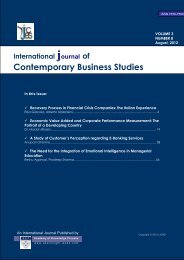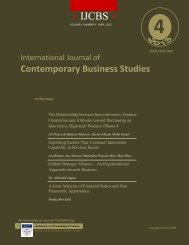Article-PDF - Academy of Knowledge Process - Webs
Article-PDF - Academy of Knowledge Process - Webs
Article-PDF - Academy of Knowledge Process - Webs
Create successful ePaper yourself
Turn your PDF publications into a flip-book with our unique Google optimized e-Paper software.
International Journal <strong>of</strong> Contemporary Business Studies<br />
Vol: 4, No: 6 JUNE, 2013 ISSN 2156-7506<br />
Available online at http://w w w.akpinsight.webs.com<br />
services to satisfy the needs <strong>of</strong> their customers. It is now a key variable in maintaining customer<br />
satisfaction. These banks are introducing internet banking as an assurance to their customers that<br />
they will be able to maintain a competitive quality <strong>of</strong> service in the future, in efforts to avoid<br />
losing their customers (Rod et al. 2009). Offering internet banking is no longer regarded as a<br />
competitive advantage but a competitive necessity (Gan et al., 2006, as cited in Rod et al. 2009).<br />
The main purpose <strong>of</strong> this study was to investigate the customers‟ perceptions towards online<br />
service quality <strong>of</strong>fered by a leading bank in Malaysia.<br />
Page | 71<br />
2.0 LITERATURE REVIEW<br />
2.1 Service Quality<br />
Service quality is generally perceived to be a tool that can be used to create a competitive<br />
advantage and therefore, substantial research into service and service quality has been<br />
undertaken in the last 20 years. Bitner et al. (1990) define service quality as “the consumers‟<br />
overall impression <strong>of</strong> the relative inferiority/superiority <strong>of</strong> the organization and its services.” The<br />
most common definition <strong>of</strong> service quality is the discrepancy between consumer‟s expectations<br />
and perceptions <strong>of</strong> the service received. Accordingly, service quality is defined as how well a<br />
delivered service level matches customer‟s expectation. Parasuraman et al. (1988, 1991)<br />
identified more detailed dimensions <strong>of</strong> service quality and developed a well-known instrument,<br />
called SERVQUAL, to measure customer‟s perceptions and expectations from service. The<br />
SERVQUAL instrument consists <strong>of</strong> five underlying dimensions, with two sets <strong>of</strong> 22 item<br />
statements for the „expectation‟ and „perception‟ sections <strong>of</strong> the questionnaire. Perceived service<br />
quality is measured by subtracting customer perception scores from customer expectation scores,<br />
both for each dimension and overall. The five dimensions <strong>of</strong> SERVQUAL are (Parasuraman et<br />
al., 1988, 1991):<br />
(1) Tangibles, which pertain to the physical facilities, equipment, personnel and<br />
communication materials.<br />
(2) Reliability, which refers to the ability to perform the promised services dependably and<br />
accurately.<br />
(3) Responsiveness, which refers to the willingness <strong>of</strong> service providers to help customers<br />
and provide prompt service.<br />
(4) Assurance, which relates to the knowledge and courtesy <strong>of</strong> employees and their ability to<br />
convey trust and confidence.<br />
(5) Empathy, which refers to the provision <strong>of</strong> caring and individualized attention to<br />
customers.<br />
Since the SERVQUAL was developed in 1988, various researchers have recognized that both the<br />
instrument itself and the conceptualization <strong>of</strong> service quality may benefit from further refinement<br />
(for example, Finn and Lamb 1991, Lee and Hing 1995). They have argued that the SERVQUAL<br />
instrument needs to be customized to the specific service area. Cronin and Taylor (1992) have<br />
developed instruments to measure service quality based only on customer perceptions. After<br />
many studies have examined the suitability <strong>of</strong> SERVQUAL in measuring service quality in<br />
different types <strong>of</strong> service, they tried to adapt the original SERVQUAL items to various service<br />
contexts by slightly changing the original items. The SERVQUAL, however, does not embrace the<br />
unique facets <strong>of</strong> online service quality, such as customer-to-Web-site interactions, since this<br />
instrument was constructed based mainly on customer-to-employee interactions (Cai and Jun, 2003).<br />
C opyright © 2 0 13. A cademy <strong>of</strong> <strong>Knowledge</strong> P rocess
















